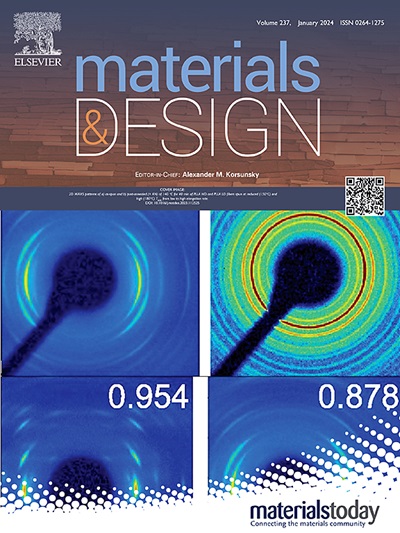Controlling the diffusion behavior in diffusion bonded reduced activation Cr0.8FeMn1.3Ni1.3 high entropy alloy/316SS joints through dislocations
IF 7.6
2区 材料科学
Q1 MATERIALS SCIENCE, MULTIDISCIPLINARY
引用次数: 0
Abstract
Diffusion bonding between Co-free Cr0.8FeMn1.3Ni1.3 high entropy alloy (HEA) and 316 stainless steel (316SS) was systematically investigated, emphasizing the enhancement of interfacial atomic diffusion through dislocation-mediated diffusion pathways induced by cold rolling deformation. The dislocation density increased significantly from 8.31 × 1012 m−2 at 0 % deformation to 7.80 × 1013 m−2 at 20 % deformation, resulting in a substantial reduction in the activation energy for diffusion from 80.5 kJ/mol to 47.2 kJ/mol, corresponding to a decrease of approximately 41 %. Concurrently, the diffusion coefficient of Fe from 316SS into the HEA notably increased from 9.35 × 10−15 m2/s to 2.15 × 10−14 m2/s, indicating significantly enhanced atomic transport. This enhanced diffusion facilitated more effective interfacial atomic mixing and continuous solid-solution formation across the joint interface. Consequently, the mechanical properties of the bonded joints improved, as evidenced by a 9 % increase in ultimate tensile strength (UTS), which is attributed to enhanced atomic intermixing and reduced local stress concentrations. The results demonstrate the effectiveness of dislocation engineering in optimizing atomic diffusion kinetics and mechanical performance in HEA/stainless steel diffusion bonded joints, offering a promising approach for enhancing joint reliability in nuclear structural applications.

通过位错控制扩散键合中的扩散行为,降低了Cr0.8FeMn1.3Ni1.3高熵合金/316SS接头的活化
系统研究了无co的Cr0.8FeMn1.3Ni1.3高熵合金(HEA)与316不锈钢(316SS)之间的扩散结合,强调了冷轧变形诱导的位错介导扩散途径对界面原子扩散的促进作用。位错密度从0%变形时的8.31 × 1012 m−2显著增加到20%变形时的7.80 × 1013 m−2,导致扩散活化能从80.5 kJ/mol大幅降低到47.2 kJ/mol,相当于降低了约41%。同时,Fe从316SS进入HEA的扩散系数从9.35 × 10−15 m2/s显著增加到2.15 × 10−14 m2/s,表明原子输运明显增强。这种增强的扩散促进了更有效的界面原子混合和在接合界面上连续的固溶形成。因此,结合接头的力学性能得到了改善,极限抗拉强度(UTS)提高了9%,这是由于原子混合增强和局部应力浓度降低。结果表明位错工程在优化HEA/不锈钢扩散键合接头的原子扩散动力学和力学性能方面是有效的,为提高核结构应用中接头的可靠性提供了一条有前途的途径。
本文章由计算机程序翻译,如有差异,请以英文原文为准。
求助全文
约1分钟内获得全文
求助全文
来源期刊

Materials & Design
Engineering-Mechanical Engineering
CiteScore
14.30
自引率
7.10%
发文量
1028
审稿时长
85 days
期刊介绍:
Materials and Design is a multi-disciplinary journal that publishes original research reports, review articles, and express communications. The journal focuses on studying the structure and properties of inorganic and organic materials, advancements in synthesis, processing, characterization, and testing, the design of materials and engineering systems, and their applications in technology. It aims to bring together various aspects of materials science, engineering, physics, and chemistry.
The journal explores themes ranging from materials to design and aims to reveal the connections between natural and artificial materials, as well as experiment and modeling. Manuscripts submitted to Materials and Design should contain elements of discovery and surprise, as they often contribute new insights into the architecture and function of matter.
 求助内容:
求助内容: 应助结果提醒方式:
应助结果提醒方式:


